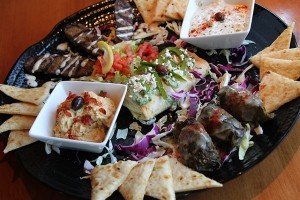A restaurant in my neighborhood closed recently. There aren’t a lot of restaurants in my neighborhood – I live in what is sometimes referred to as “the world’s largest cul-de-sac,” a sprawling suburban development that only has one entry and exit point. There’s a bar serving bar food and a pseudo-Mexican/American place flanking a hardware store, both owned by the same people; there’s a McDonald’s and a drive-through taqueria, and a Subway franchise. The Jack-in-the-Box and the pizza place closed at the beginning of the Great Recession and are still empty. So, I was happy when this restaurant opened a year and a half ago, the eighth or ninth in a locally-owned group, in a spot in a shopping plaza that had seen four restaurants in eight years. At first I thought that this one might actually be a success. The group’s location on the main drag near campus is always hopping and the one downtown seems to be doing fine. The menu was essentially the  same, featuring really large portions of Greek-inspired favorites. Same menu, same organization, with a track-record of success – it should work, shouldn’t it? Well it didn’t.
same, featuring really large portions of Greek-inspired favorites. Same menu, same organization, with a track-record of success – it should work, shouldn’t it? Well it didn’t.
I don’t know the details of the restaurant’s closure, but it got me thinking about arts organizations (especially nonprofit theatres) and community relationships. As the old real estate adage goes, the three most important factors are location, location, location. The restaurant group’s successful locations all have something my location didn’t: foot traffic. That is, people in the neighborhood for other reasons that stop in for lunch or dinner. The location near me would have to be a destination but the programming didn’t warrant that: nobody travels out to the burbs for a Greek diner unless it offers something truly unique and wonderful. If you think of the menu as the programming, as the season selection, there is another important lesson to be learned here: the same programming doesn’t necessarily work for every community. We all know this, we would never admit to thinking otherwise, yet, as we look at TCG’s annual season preview (OK, I’m a bit late, it was published in October), we see this phenomenon happening across the country. Arkansas Rep’s season looks remarkably like Arizona Theatre Company’s did last year; and ATC’s season overlaps with Indiana Rep’s. Can similar menus play successfully in such disparate regions? Perhaps, unlike the restaurant on the corner, these theatres really are playing to the same community, a kind of homogenized American theatre-going community rather than one distinctive or unique to the region.
Shortly before the restaurant on the corner closed, a new one opened kitty-corner to it (unfortunately, a McDonald’s makes it hard to see the new place from the street). This new restaurant has a limited menu of pasta, salads, and sandwiches, relatively low prices, and friendly service. It’s far from perfect, but at least it’s designed to fit the neighborhood.
(photo from Pitch.com)
